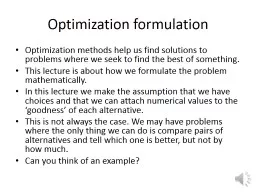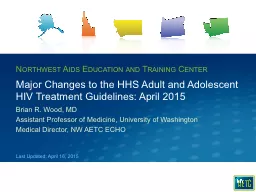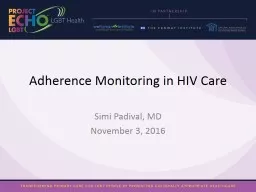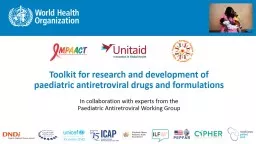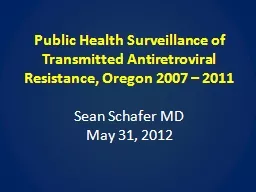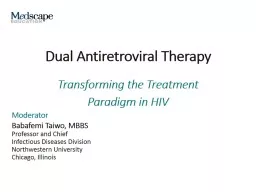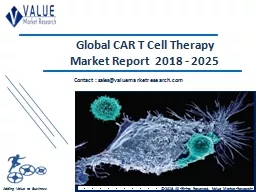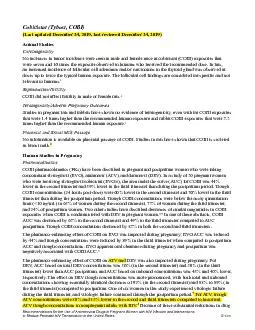PPT-Optimization of Antiretroviral Therapy
Author : belinda | Published Date : 2024-03-13
With Emergence of Comorbidities Roger J Bedimo MD Professor of Medicine University of Texas Southwestern Medical Center Dallas TX Learning Objectives On completion
Presentation Embed Code
Download Presentation
Download Presentation The PPT/PDF document "Optimization of Antiretroviral Therapy" is the property of its rightful owner. Permission is granted to download and print the materials on this website for personal, non-commercial use only, and to display it on your personal computer provided you do not modify the materials and that you retain all copyright notices contained in the materials. By downloading content from our website, you accept the terms of this agreement.
Optimization of Antiretroviral Therapy: Transcript
With Emergence of Comorbidities Roger J Bedimo MD Professor of Medicine University of Texas Southwestern Medical Center Dallas TX Learning Objectives On completion of this presentation learners will be able to. CSE 8330. Instructor: . Dr.Margaret. H. Dunham. Presenter: . Akshaya. . Aradhya. Introduction. Query optimization in XML databases. Query optimization in Parallel databases. Comparison. Conclusion and Future work. Optimization methods help us find solutions to problems where we seek to find the best of something.. This lecture is about how we formulate the problem mathematically.. In this lecture we make the assumption that we have choices and that we can attach numerical values to the ‘goodness’ of each alternative.. Brian R. Wood, MD. Assistant Professor of Medicine, University of Washington. Medical Director, NW AETC ECHO. Last Updated. : April 16, 2015. Source: . HHS . Antiretroviral Therapy Guidelines. . AIDS Info (www.aidsinfo.nih.gov). Simi Padival, MD. November 3, 2016. Objectives. Learn about the importance of assessing adherence to antiretroviral therapy (ART). Learn about the components of assessing for ART adherence. Discuss frequency of monitoring while on ART. Module 10:. Pharmacovigilance. Background – definitions. Timeline of pharmacovigilance for a drug from development (pre-market) to post-marketing use. Burden of adverse drug reactions in children. Number of pharmacoepidemiological safety studies in children (Osokogu et al, 2016). Sean Schafer MD. May 31, 2012. Three Studies in One. Evaluating antiretroviral drug resistance surveillance in Oregon. Determining frequency of transmitted antiretroviral drug resistance, comparing to U.S.. This program will include a discussion of off-label treatment and investigational agents not approved by the FDA for use in the United States and data that were presented in abstract form. These data should be considered preliminary until published in a peer-reviewed journal.. Car T Cell Therapy Market report provides the future growth trend of the market based on in-depth research by industry experts.The global and regional market share along with market drivers and restraints are covered in the report. View More @ https://www.valuemarketresearch.com/report/car-t-cell-therapy-market اختصاصي الامراض الباطنة . البورد العربي . كلية طب الموصل . . 2013. Short-Course Antiretroviral Therapy in Primary HIV Infection. Joseph J. Eron, Jr, MD Professor of Medicine and Epidemiology The University of North Carolina at Chapel Hill Chapel Hill, North Carolina Future Directions: Investigational Approaches to Antiretroviral Therapy G-103 Ckbeceopap (Pubkop( CO>E) (Last updated December 24, 2019, last reviewed December 24, 2019)Carcinogenicity Recommendations for the Use of Antiretroviral Drugs in Pregnant Women with HIV Infectio Antiretroviral Pregnancy Registry. LM Mofenson, V . Vannappagari. , AE . Scheuerle. , B Baugh,. KP Beckerman, H . Betman. , N . Chakhtoura. , K Dominguez, A . Pikis. , NS . Santanello. (Last updated December 30, 2021; last reviewed December 30, 2021) Panel’s Recommendations When acute HIV infection is suspected in pregnancy or during breastfeeding, a plasma HIV RNA test should Michael Kantor. CEO and Founder . Promotion Optimization Institute (POI). First Name. Last Name. Company. Title. Denny. Belcastro. Kimberly-Clark. VP Industry Affairs. Pam. Brown. Del Monte. Director, IT Governance & PMO.
Download Document
Here is the link to download the presentation.
"Optimization of Antiretroviral Therapy"The content belongs to its owner. You may download and print it for personal use, without modification, and keep all copyright notices. By downloading, you agree to these terms.
Related Documents


